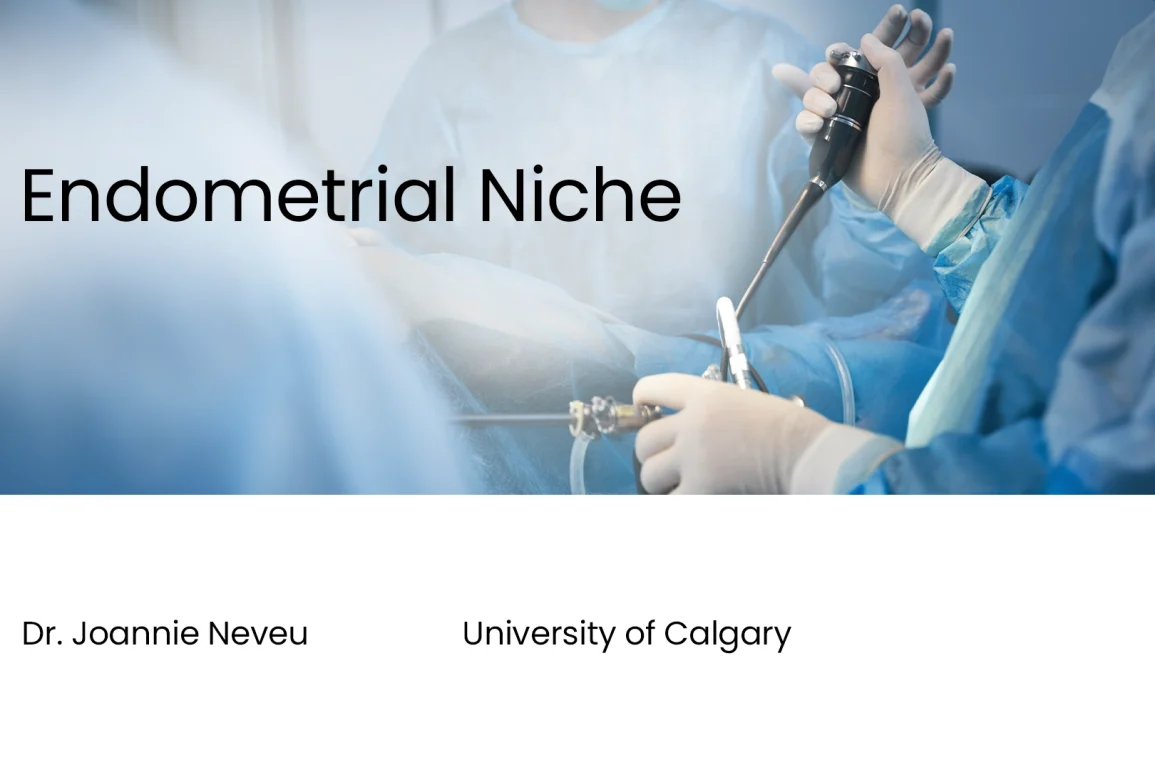Table of Contents
Video Description
This video outlines the surgical management of an endometrial niche (isthmocele) through a laparoscopic approach.
Presented By

Affiliations
University of Calgary
See Also
Watch on YouTube
Click here to watch this video on YouTube.
What is Endometrial Niche?
An “Endometrial Niche,” also known as a cesarean scar defect, is a clinical condition often observed in women who have undergone a cesarean section (C-section). It refers to an area within the uterine wall, specifically at the site of the cesarean section scar, where the muscular tissue is deficient. This area can create a small pouch or indentation at the site of the scar in the endometrium, the mucous membrane lining the uterus.
What are the Risks of Endometrial Niche?
Endometrial niche, or cesarean scar defect, can be associated with several risks and complications, particularly if it’s substantial in size or depth. Here are some of the risks associated with an endometrial niche:
-
Abnormal Bleeding
-
Pelvic Pain
-
Fertility Issues
-
Cesarean Scar Pregnancy (CSP)
-
Uterine Rupture
-
Endometriosis
-
Adhesions
While the presence of an endometrial niche is relatively common following a cesarean delivery and most women do not experience significant complications, it’s important for symptoms or potential risks to be evaluated and monitored by a healthcare professional, especially for women planning future pregnancies. Treatment decisions are usually based on symptom severity, the depth and size of the niche, and individual reproductive plans.
Video Transcript: Endometrial Niche
This video will be presenting the case of a patient with a symptomatic endometrial niche.
The definition of an endometrial niche is mostly based on radiological findings. It is not universal. It has been defined as a triangular anechoic area at the caesarean scar site that is contiguous with the endometrial cavity.
The incidence of endometrial niche is widely variable depending on population, diagnostic criteria, and imaging modality. The incidence rate do not imply the presence of symptoms. Symptoms may be seen in 30% to 50% of patient.
Several risk factors have been described including surgical, labouring, and wound healing component. Several diagnostic modalities have been described, the transvaginal ultrasound being the most common. Saline infusion sonohysterogram is also used as primary modality as it is more sensitive and more specific. The MRI is very useful preoperatively.
Today we present the case of a 33-year-old, G4P3, healthy patient with three prior caesarean section. Her main complaint were heavy menstrual bleeding and postmenstrual spotting.
This patient had a complete work up with investigation and treatment by her general gynaecologist. The patient went through several imaging investigations including ultrasound. This was followed by an MRI in 2016. The MRI showed a defect of approximately 2x2x3 cm in the intrauterine wall. The remaining thickness of the myometrium was only 2 mm. It also put in evidence the bladder adhesions at the level of the hysterotomy site.
After laparoscopic entry, the anatomy was surveyed, and the bladder adhesions were easily visualised. There were no evidence of other pathology including endometriosis.
In regards of treatment, the only indication is the presence of symptoms. There is insufficient evidence to support revision for prevention of adverse obstetrical outcome.
Our patient failed medical hormonal management due to side effect. She also declined the use of levonorgestrel IUS. Furthermore, this patient had future fertility plans.
After consideration of the multiple surgical approaches that have been described, we decided to proceed with a laparoscopic repair assisted with hysteroscopy.
This approach has been shown to improve symptoms in 80 to 100% of the patient. In one specific study published in 2016 with 38 patient, 87% were symptom free at one to six years, 44% had live birth, and 8% only of the patient had no symptoms improvement.
Furthermore, preoperative MRI showed an average myometrial thickness of 1.4 mm, and postoperative MRI showed an average of 9.6 mm. However, this has an unknown significance for obstetrics or gynaecological outcome.
We started by dissecting the bladder off the anterior aspect of the uterus and the cervix. The bladder was dissected all the way to the level of the pubocervical fascia.
The uterine artery was identified. The incision was extended laterally all the way to its level. This was carried out bilaterally.
The defect was first identified by palpation through the interior uterine wall. Different technique can be used to identify the defect. This can be done under hysteroscopy guidance, under ultrasound guidance, or simply with the use of a cervical dilator. In this case we used the hysteroscope to transilluminate the defect.
We then use the ultrasonic blade of the electrosurgical device in order to mark the defect. The instrascope was then removed and replaced by a cervical dilator. The portion to be removed was then grasped and we use our electrosurgical device in order to proceed with dissection and resection.
We obtain proper hemostasis as we went along on order to maintain good visualisation along the case. The cervical dilator was a useful tool to maintain uterine mobilisation throughout the case. It also helped to identify proper surgical plane at the time of closure.
The specimen was retrieved. It measured approximately 2 cm. We then initiated the closure. Various method have been reported. We used a barbed suture to do a full thickness closure including myometrium and endometrium.
At the end of the case, the anastomosis was check with hysteroscopic installation of saline. It was found to be complete.
In conclusion, over the last few years we observed an increased rate of caesarean scar niche. This is likely due to the increase in investigation and caesarean section rate overall. The first line diagnostic modality suggested would be a transvaginal ultrasound or a saline infusion sonohysterogram. However, the preferred imaging modality for surgical planning would be an MRI.
We recommend for symptomatic patient only to combine laparoscopic, hysteroscopic approach to achieve optimal result.


